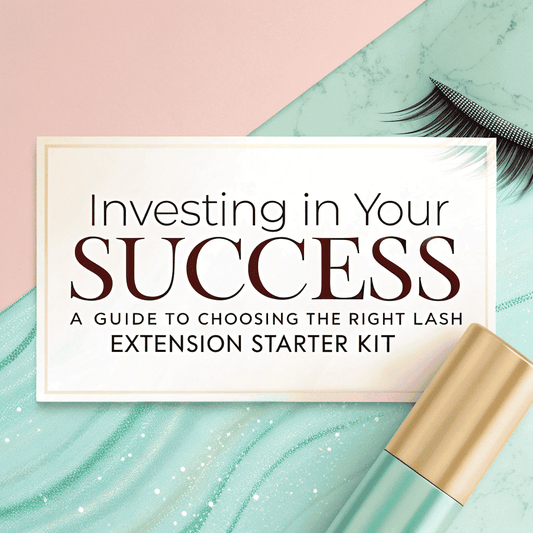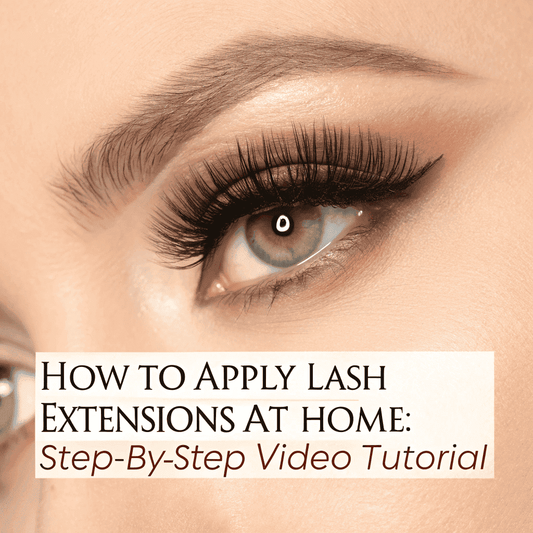The Origins of Fake Eyelashes: Who First Created Them?
Ever wondered who invented fake eyelashes? Fashion trends may come and go, but some beauty innovations stick around and change the game forever. Fake eyelashes are one of these. They started as an extravagant theatrical accessory and have become an essential item in today’s beauty toolkit.
The journey of fake eyelashes is fascinating. It’s a story full of creativity, a touch of Hollywood glamor, and the ever-evolving beauty industry. Let’s dive in and discover who we have to thank for this fabulous invention and how it has transformed over the years.
The Surprising Birth of Fake Eyelashes
The origin of fake eyelashes may surprise you, dating back much earlier than you might expect. In 1882, Henry Labouchère reported that Parisians discovered a novel method: sewing hair directly into their eyelids to create a more attractive eye appearance.
Fast forward to the early 20th century, and film needed actors' faces to be expressive, especially during the silent film era. This led to more practical, less invasive fake eyelashes.
In 1911, Anna Taylor patented the first false eyelashes in the U.S. Her design featured a crescent-shaped strip of fabric with tiny pieces of hair, forming the basis for today's lashes. This was a safer and more comfortable alternative to earlier methods.
Thanks to these advancements, actresses could easily get those glamorous eyes that audiences loved. Fake eyelashes quickly became popular, not just in Hollywood, but among everyday women wanting to emulate their favorite stars.

Early Innovations in Eyelash Enhancement
Long before we had the luxury of synthetic fibers and fancy application techniques, fake eyelashes were created using much simpler methods. In 1902, Karl Nessler, a clever innovator, patented a method for making artificial eyebrows and eyelashes. By 1903, he was already selling these handmade lashes at his London salon, taking the first steps toward what would later become a huge industry.
These early lashes were very different from the easy-to-use strips and clusters we have today. Back then, they involved sewing real hair onto a thin fabric base, which created a natural but delicate look. Despite the simplicity, these early designs set the stage for future innovations. In 1911, Canadian inventor Anna Taylor made a big leap forward by patenting artificial eyelashes, which she crafted from human hair. This was a significant moment in the history of beauty products.
The early 20th century saw a rise in cinema, which boosted the demand for more expressive eye makeup, including these pioneering eyelashes. Actresses needed to show their emotions clearly on black-and-white film, and fake lashes provided the dramatic flair they needed. This trend quickly caught on with everyday women, who wanted to copy the glamorous looks they saw on the big screen.
The Creator Behind the Glamorous Lashes
When you think of those stunning, fluttery lashes, it's essential to acknowledge the masterminds behind their creation. One primary figure in the history of false eyelashes is Canadian inventor Anna Taylor, who patented the first artificial lashes in 1911. Taylor's design was a game-changer. She devised a way to embed tiny hairs into a crescent-shaped fabric, creating a more natural-looking eyelash enhancement compared to earlier, cruder methods.
But the innovation didn't stop there. Enter Maksymilian Faktorowicz, better known as Max Factor—a pioneer in the beauty industry and the founder of the Max Factor brand. Faktorowicz refined Taylor's concept, developing lashes that were not only practical for everyday wear but also perfect for the stage and screen. These innovations fed directly into the burgeoning film industry, enhancing actors' expressions and making their eyes pop on the big screen.
Thus, both Taylor and Faktorowicz played pivotal roles in transforming false eyelashes from rudimentary fabric pieces into sophisticated beauty accessories. Their contributions laid the groundwork for what would become a staple in makeup kits worldwide. Sometimes, it's the smallest details that can create the most significant impact.

Who is Credited With Inventing Fake Eyelashes?
Ancient Times: Egyptians and Romans use various methods to darken and lengthen their eyelashes.
1911: Canadian inventor Anna Taylor patents the first artificial eyelashes, thought to be made from human hair.
1916: During the filming of 'Intolerance,' D.W. Griffith wants actress Seena Owen’s eyes to stand out. He collaborates with a local wigmaker to weave human hair through fine gauze, creating the first modern fake eyelashes.
1930s-1940s: The use of fake eyelashes spreads gradually, primarily within the film industry to enhance actors' on-screen presence.
1950s: Significant advancements in materials and adhesives make fake eyelashes more comfortable and accessible. Hollywood stars like Marilyn Monroe, Judy Garland, and Rita Hayworth popularize voluminous lashes.
1960s: Fake eyelashes become a beauty staple in the Western world, driven by fashion icons and cultural trends.
1970s-1980s: Fake lashes gain wider acceptance, with synthetic materials like nylon and polyester becoming more common due to affordability and durability.
1990s: Innovations in lash design and materials, such as silk, provide luxurious options with a natural sheen.
2000s-Present: Modern innovations continue, with a growing trend in DIY eyelash application and celebrity endorsements further cementing their place in beauty culture.

How Did the Invention of Fake Eyelashes Impact the Beauty Industry?
The invention of fake eyelashes changed the beauty game forever. Before them, you only had mascara, eyeliner, and eyeshadow. But fake eyelashes? They gave your look a fast, dramatic boost, making eyes look bigger and more expressive. Suddenly, makeup artists and regular folks could create looks that were once impossible.
Making Glamour Accessible: Fake lashes weren't just for Hollywood stars anymore. Although initially popularized in the early 20th century by iconic movie stars, soon women everywhere were wearing them. The magic of movie-star glamour was now just a pair of lashes away, which led to a boom in the beauty industry with various brands and styles emerging.
Innovation Explosion: This invention sparked waves of innovation. Companies started experimenting with new materials, adhesives, and designs to create comfortable, durable, and natural-looking lashes. Now we have magnetic lashes, lash extensions, and even semi-permanent options—each catering to different needs and tastes. The constant evolution keeps the market fresh and competitive.
Cultural Impact: Fake eyelashes didn't just change beauty products; they made a cultural mark too. They've become key elements in beauty trends across the world. Whether it's the dramatic lashes of drag queens or the subtle enhancements for everyday office wear, fake eyelashes are versatile tools of self-expression, solidifying their place in the beauty industry.
Economic Impact: The demand for false lashes has created a multi-billion-dollar market, covering everything from the lashes themselves to applicators, adhesives, and removers. This booming market has opened doors for entrepreneurs and businesses of all sizes, from big cosmetic giants to small indie brands.
Boosting Beauty Education: Fake eyelashes have shaped beauty education and professional makeup artistry. Makeup schools and courses now include specialized training in applying and maintaining these lashes. This skill set is now a must-have for makeup artists, enabling them to create various looks and cater to diverse needs. This professionalization has boosted the status of fake eyelashes in the beauty industry.

Were There Any Notable Figures or Celebrities Who Popularized Fake Eyelashes?
1916: One of the first big names to bring fake eyelashes into the spotlight was legendary film director D.W. Griffith. Back in 1916, he wanted actress Seena Owen to have lashes that brushed her cheeks for the movie Intolerance. So, a local wig maker crafted the first set using human hair and fine gauze. These early falsies were quite the innovation!
1960s: Fast forward to the 1960s, and we see British model and actress Twiggy taking fake eyelashes to new heights. Known for her dramatic eye makeup, Twiggy's signature look with bold false lashes became the trendsetter of the Swinging Sixties. She made those lashes a must-have!
1970s: The 1970s were all about disco and glitter. Stars like Cher and Diana Ross rocked extravagant makeup and false eyelashes, making them even more popular. Their glam looks encouraged fans everywhere to try out fake lashes and add some drama to their style.
Recent Years: Recently, celebs like Kim Kardashian and Lady Gaga have kept the fake eyelash trend alive and kicking. Kim, with her massive influence in the beauty industry and social media, has made them a modern makeup staple. Meanwhile, Lady Gaga's unique and theatrical style shows just how versatile those falsies can be.
Mid-20th Century: As the magic of the silver screen started captivating audiences worldwide, the demand for products that could replicate the dramatic, expressive eyes of film stars skyrocketed. Fake eyelashes, initially used almost exclusively on film sets, started making their way into mainstream beauty routines. By the mid-20th century, women everywhere were inspired to emulate Hollywood starlets like Audrey Hepburn and Marilyn Monroe, whose voluminous lashes became iconic symbols of glamour. This period marked a significant transition for false eyelashes, turning them from a theatrical accessory into a common item on beauty shelves.
With innovations in production techniques, false eyelashes became more accessible and diversified. In the past, they were often handmade and could be quite costly. However, advances in manufacturing made them more affordable and available in a variety of styles to suit different tastes and occasions.
The 1960s in particular witnessed an explosion in the popularity of bold, exaggerated eye makeup. Think of Twiggy's famous doe-eyed look—false eyelashes weren't just an add-on; they were the focal point of the entire makeup routine. From there, the trend only grew, with everyday women embracing eyelash enhancements to add a touch of elegance and drama to their daily lives.

Evolution of Materials and Techniques
From humble beginnings to cutting-edge designs, the journey of false eyelashes is fascinating. It began in 1911, when Anna Taylor created fake eyelashes using a fabric base. Although groundbreaking, these early lashes were handmade and came with adhesives that were nowhere near as effective as today's versions.
Over the years, eyelash materials saw major advancements. The original fabric bases were soon replaced by durable and flexible plastics and synthetic fibers. This made lashes more comfortable and allowed for mass production, enabling more people to enjoy them.
The 1950s: This decade brought mink lashes, made from real mink fur. They were luxurious and natural-looking, but also raised ethical concerns. This led to the creation of high-quality synthetic alternatives, which looked just as beautiful without using animal fur.
Manufacturers then began experimenting with different textures and styles:
- Silk Lashes: Known for their smooth finish and lightweight feel.
- Velour Lashes: Offered a plush and dramatic look, perfect for glamorous occasions.
Today’s false eyelashes are crafted with advanced techniques, ensuring they are uniform and comfortable. Adhesives have also improved significantly, featuring stronger, latex-free formulas that keep your lashes secure all day long.
One of the most recent innovations is magnetic lashes. These use tiny magnets to attach to your natural lashes, making the application quicker and easier, with no glue needed.
Whether you prefer the classic look of silk lashes or the convenience of magnetic ones, the evolution of eyelash materials and techniques has made it easier for everyone to get that perfect, fluttering look.

Hollywood's Influence on Eyelash Trends
The allure and mystique of Hollywood have long shaped beauty standards, and fake eyelashes are no exception. From the glamorous days of the 1950s and 1960s, stars like Marilyn Monroe, Judy Garland, and Rita Hayworth brought bold and voluminous lashes into the limelight.
Their influence was undeniable—women worldwide aspired to replicate the seductive and captivating looks of these silver screen icons.
This fascination with dramatic eyelashes wasn't just about aesthetics. It was rooted in the need for innovation on film sets. Directors and makeup artists quickly realized that expressive eyes could tell a story without words. Thus, false eyelashes emerged as a tool to enhance the actors' on-screen presence.
As the decades rolled by, each generation of actresses and fashion icons left their mark on eyelash trends. In the 1970s, the look evolved to embrace longer, more natural styles. The 1980s and 1990s favored a return to boldness, albeit with a modern twist. Hollywood's ongoing experimentation kept false eyelashes in the beauty spotlight, making them a staple both on and off the screen.
Today, the impact of those early Hollywood trailblazers continues to resonate. As you scroll through social media or watch a red-carpet event, the signature voluminous lashes once reserved for movie stars are now a must-have accessory for anyone looking to make a bold beauty statement.
How False Eyelashes Became a Beauty Staple
Have you ever wondered when false eyelashes transitioned from a niche product to a mainstream beauty essential? The climb to fame wasn't straightforward, but filled with fascinating twists and turns.
Initially made for theatrical purposes in the early 20th century, fake lashes gained wide acceptance thanks to Hollywood's glamour. Stars like Marilyn Monroe and Judy Garland helped make them a must-have in everyday beauty routines.
“The global false eyelashes market size was valued at $1.1 billion in 2018”
The Mod Fashion Boom
One key moment was the rise of the mod fashion trend in the 1960s. Icons like Twiggy showed off dramatic, doe-eyed looks, turning false eyelashes into a must-have item. By this time, they weren't just for the elite or movie stars—women from all walks of life could wear them.
The Digital Revolution
Fast forward a few decades, and fake eyelashes are a big part of the billion-dollar beauty industry. Thanks to social media platforms like Instagram and YouTube, influencers and makeup artists showcase how to use them safely and creatively. This digital era has turned false eyelashes into not just a beauty staple, but a pop culture phenomenon.
Endless Possibilities
As technology evolves, so do the options for false eyelashes. From magnetic lashes to semi-permanent extensions, the possibilities are endless. This ensures that fake lashes will remain a strong part of beauty routines for generations to come.

Cultural Impact of False Eyelashes Through the Decades
False eyelashes have truly evolved over the years. Today, they're more than just simple beauty enhancers; they're sophisticated tools tailored to meet diverse tastes and needs. One game-changing innovation is magnetic false eyelashes. Created by Katy Stoka in 2014, these lashes use tiny magnets instead of glue, making them easier to apply and gentler on your skin.
Modern false lashes come in various materials like synthetic fibers, mink, and silk. Synthetic lashes are budget-friendly and offer a range of bold styles. Mink lashes, on the other hand, give a more natural look and can be reused if taken care of properly.
From different shapes to varied styles, today's false lashes cater to all eye shapes and occasions. Whether you're going for a subtle boost or a dramatic flair, there's a pair just for you.
Thanks to DIY eyelash kits, applying falsies at home has never been easier. These kits usually include several lash styles, adhesives, and applicators. They're perfect for newbies looking to explore and find their ideal style without spending a fortune.
DIY Eyelashes: A Growing Trend
It's clear that celebrities have always played a massive role in making false eyelashes popular and accepted. When iconic stars like Marilyn Monroe, Judy Garland, and Rita Hayworth wore dazzling lashes, they weren't just doing it for the screen. These actresses set real-world beauty trends that fans eagerly followed. The Hollywood glam of the '50s and '60s made fake eyelashes a mainstream beauty must-have.
Fast forward to today, and celebrities are still key players in the false eyelash industry. Pop culture icons like Kim Kardashian, Lady Gaga, and Beyoncé flaunt dramatic lashes, turning them into must-have fashion items. Social media has amplified this impact, allowing these stars to showcase their favorite beauty tips and products to millions of followers instantly.
Moreover, the rise of beauty influencers on platforms like Instagram and YouTube has changed the beauty game. Influencers, seen as more relatable than traditional celebrities, share tutorials and product reviews that make fake eyelashes more approachable. Collaborations between these influencers and eyelash brands have cemented false eyelashes' status as essential beauty tools.
Whether endorsed by a beloved actress or demonstrated by a favorite beauty guru, celebrities continue to shape the trends and acceptance of false eyelashes. These endorsements not only highlight the glamour of fake eyelashes but also introduce new designs and application techniques, keeping the trend fresh and exciting.

False Eyelashes in Social Media Culture
In today's digital age, false eyelashes have become a social media sensation. Platforms like Instagram, TikTok, and YouTube are filled with tutorials, reviews, and selfies showing off the versatility of these beauty enhancers. Influencers and beauty gurus share tips and tricks, boosting the popularity of different styles and brands, and creating a community of lash enthusiasts.
Hashtags like #Falsies, #LashExtensions, and #LashGoals have millions of posts, turning the simple fake eyelash into a viral phenomenon. Whether for daily wear or special events, social media has made beauty standards more inclusive, letting more people try out different looks and products.
User-generated content is a big part of this trend. Everyday users share their lash transformations, making false eyelashes seem doable for everyone. This flood of content creates an inclusive space where both beginners and experts can find inspiration and advice.
Also, when influencers team up with brands, they often create limited-edition products or exclusive lines that spark excitement in the community. This partnership drives new trends and keeps false eyelashes in the spotlight.
So, whether you're scrolling through your feed or watching a tutorial, social media keeps you updated on the latest lash trends, making it easier than ever to find the perfect pair to elevate your look.
How to Choose the Right Fake Eyelashes for You
Choosing the right fake eyelashes can transform your entire look, but with so many options, it can feel overwhelming. Don't worry, we're here to help!
1. Understand Your Eye Shape
Knowing your eye shape is key. Almond eyes are versatile and suit most styles, but cat-eye lashes highlight their natural curve beautifully. For round eyes, pick lashes longer in the center for an illusion of length. Hooded eyes benefit from shorter bands and natural styles to avoid overshadowing.
2. Consider the Occasion
Are you aiming for a bold night-out look or something subtle for daily wear? Natural-looking lashes are perfect for everyday, while dramatic "doll eye" styles add flair for special events. Tailor your choice to the occasion.
3. Choose the Right Material
Lashes come in materials like synthetic, silk, and mink. Synthetic lashes are affordable and great for beginners. Silk lashes feel natural and lightweight, while mink lashes offer luxury with their soft, feathery texture. Pick what suits your comfort and budget.
Pro Tip: If you wear glasses or contacts, go for lighter, shorter lashes to avoid discomfort.
4. Explore Different Types
From strip lashes to individual, cluster, and magnetic lashes, the type you choose matters. Strip lashes are easy to apply, ideal for beginners. Individual and cluster lashes offer more customization but need some skill. Magnetic lashes skip the adhesive, making application simpler.
5. Trial and Error
Don’t be afraid to try different styles to see what works best. Many brands offer variety packs, great for experimenting without commitment. Remember, practice makes perfect, and finding the right eyelashes takes time and patience.
With these tips, you're ready to choose false eyelashes that enhance your natural beauty and achieve the look you desire.
Maintaining your false eyelashes is essential if you want to keep them looking fabulous and lasting longer. Here are some tips and tricks to help you take the best care of your falsies:
Cleaning Your Lashes
After each use, it's important to clean your false eyelashes. Gently peel off any excess glue using tweezers. Next, place the lashes on a clean, flat surface and dab them with a cotton swab dipped in oil-free makeup remover. This helps to remove mascara and buildup without damaging the lashes.
Storing Your Lashes
Proper storage can significantly extend the life of your lashes. Store them in their original packaging or a dedicated lash case. This helps to maintain their shape and protect them from dust and bacteria.
Avoiding Damage
Be gentle when handling your false eyelashes. Avoid pulling or tugging, as this can deform the lash band or cause the individual lashes to fall out. Always use a soft grip when removing them from your eyes or the storage case.
Choosing the Right Adhesive
Your choice of adhesive can make a huge difference. Opt for a high-quality, latex-free adhesive to prevent allergic reactions. Make sure it's suitable for your skin type and provides a strong yet comfortable hold.
Reusing Your Lashes
If looked after properly, most false eyelashes can be reused multiple times. Clean them thoroughly and store them carefully between uses. Pay attention to signs of wear and tear; once they lose their shape or start shedding, it's time to replace them.
By following these tips and tricks, you'll keep your false eyelashes looking gorgeous and ready to enhance your eyes, no matter the occasion. Happy lashing!
Conclusion
False eyelashes have evolved tremendously since they were first created. They are now a must-have in many beauty routines! Whether you’re aiming for a natural look or something bold and dramatic, there’s a pair of lashes out there just for you.
Want to elevate your beauty game? Explore the endless options and find your perfect match online today!



